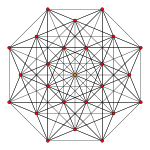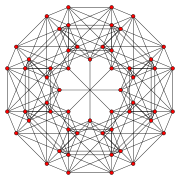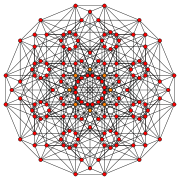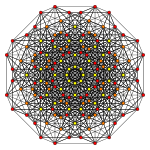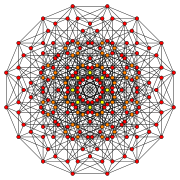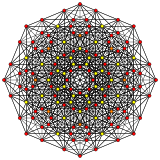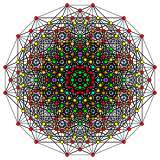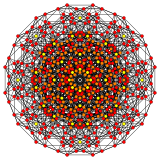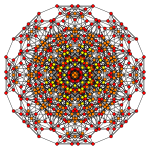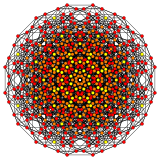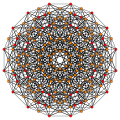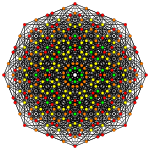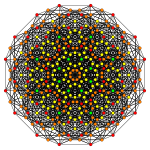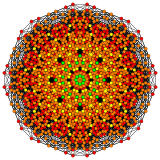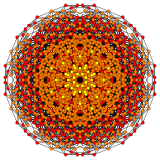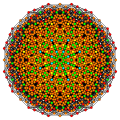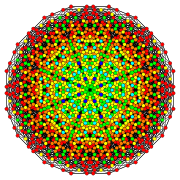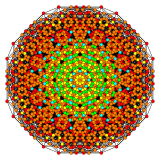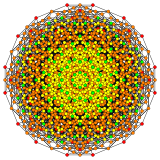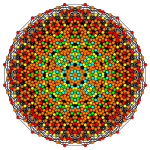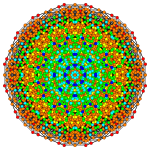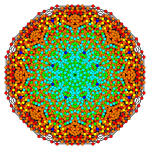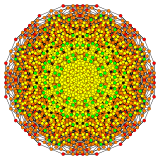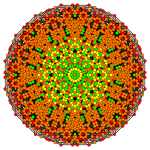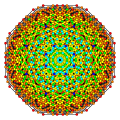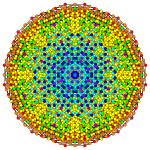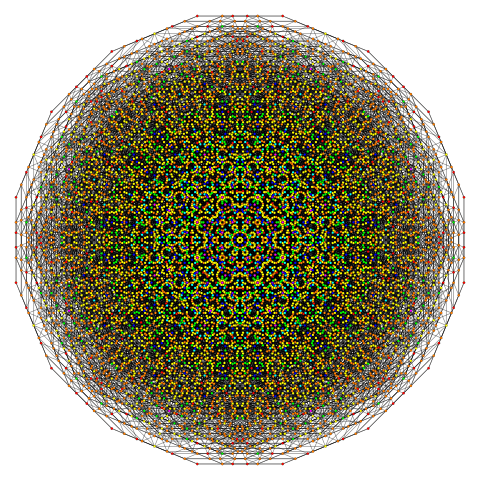7-simplex
| Regular octaexon (7-simplex) | |
|---|---|
 Orthogonal projection inside Petrie polygon | |
| Type | Regular 7-polytope |
| Family | simplex |
| Schläfli symbol | {3,3,3,3,3,3} |
| Coxeter-Dynkin diagram | |
| 6-faces | 8 6-simplex |
| 5-faces | 28 5-simplex |
| 4-faces | 56 5-cell |
| Cells | 70 tetrahedron |
| Faces | 56 triangle |
| Edges | 28 |
| Vertices | 8 |
| Vertex figure | 6-simplex |
| Petrie polygon | octagon |
| Coxeter group | A7 [3,3,3,3,3,3] |
| Dual | Self-dual |
| Properties | convex |
In 7-dimensional geometry, a 7-simplex is a self-dual regular 7-polytope. It has 8 vertices, 28 edges, 56 triangle faces, 70 tetrahedral cells, 56 5-cell 5-faces, 28 5-simplex 6-faces, and 8 6-simplex 7-faces. Its dihedral angle is cos−1(1/7), or approximately 81.79°.
Alternate names
It can also be called an octaexon, or octa-7-tope, as an 8-facetted polytope in 7-dimensions. The name octaexon is derived from octa for eight facets in Greek and -ex for having six-dimensional facets, and -on. Jonathan Bowers gives an octaexon the acronym oca.[1]
As a configuration
The elements of the regular polytopes can be expressed in a configuration matrix. Rows and columns reference vertices, edges, faces, and cells, with diagonal element their counts (f-vectors). The nondiagonal elements represent the number of row elements are incident to the column element. The configurations for dual polytopes can be seen by rotating the matrix elements by 180 degrees.[2][3]
Coordinates
The Cartesian coordinates of the vertices of an origin-centered regular octaexon having edge length 2 are:
More simply, the vertices of the 7-simplex can be positioned in 8-space as permutations of (0,0,0,0,0,0,0,1). This construction is based on facets of the 8-orthoplex.
Images
| 7-Simplex in 3D | ||||||
 Ball and stick model in triakis tetrahedral envelope |
 7-Simplex as an Amplituhedron Surface |
 7-simplex to 3D with camera perspective showing hints of its 2D Petrie projection | ||||
| Ak Coxeter plane | A7 | A6 | A5 |
|---|---|---|---|
| Graph |  |
 |
 |
| Dihedral symmetry | [8] | [7] | [6] |
| Ak Coxeter plane | A4 | A3 | A2 |
| Graph |  |
 |
 |
| Dihedral symmetry | [5] | [4] | [3] |
Related polytopes
This polytope is a facet in the uniform tessellation 331 with Coxeter-Dynkin diagram:
This polytope is one of 71 uniform 7-polytopes with A7 symmetry.
Notes
- ↑ Klitzing, Richard. "7D uniform polytopes (polyexa) x3o3o3o3o3o - oca".
- ↑ Coxeter, Regular Polytopes, sec 1.8 Configurations
- ↑ Coxeter, Complex Regular Polytopes, p.117
External links
- Glossary for hyperspace, George Olshevsky.
- Polytopes of Various Dimensions
- Multi-dimensional Glossary
Fundamental convex regular and uniform polytopes in dimensions 2–10 | ||||||||||||
|---|---|---|---|---|---|---|---|---|---|---|---|---|
| Family | An | Bn | I2(p) / Dn | E6 / E7 / E8 / F4 / G2 | Hn | |||||||
| Regular polygon | Triangle | Square | p-gon | Hexagon | Pentagon | |||||||
| Uniform polyhedron | Tetrahedron | Octahedron • Cube | Demicube | Dodecahedron • Icosahedron | ||||||||
| Uniform 4-polytope | 5-cell | 16-cell • Tesseract | Demitesseract | 24-cell | 120-cell • 600-cell | |||||||
| Uniform 5-polytope | 5-simplex | 5-orthoplex • 5-cube | 5-demicube | |||||||||
| Uniform 6-polytope | 6-simplex | 6-orthoplex • 6-cube | 6-demicube | 122 • 221 | ||||||||
| Uniform 7-polytope | 7-simplex | 7-orthoplex • 7-cube | 7-demicube | 132 • 231 • 321 | ||||||||
| Uniform 8-polytope | 8-simplex | 8-orthoplex • 8-cube | 8-demicube | 142 • 241 • 421 | ||||||||
| Uniform 9-polytope | 9-simplex | 9-orthoplex • 9-cube | 9-demicube | |||||||||
| Uniform 10-polytope | 10-simplex | 10-orthoplex • 10-cube | 10-demicube | |||||||||
| Uniform n-polytope | n-simplex | n-orthoplex • n-cube | n-demicube | 1k2 • 2k1 • k21 | n-pentagonal polytope | |||||||
| Topics: Polytope families • Regular polytope • List of regular polytopes and compounds | ||||||||||||
